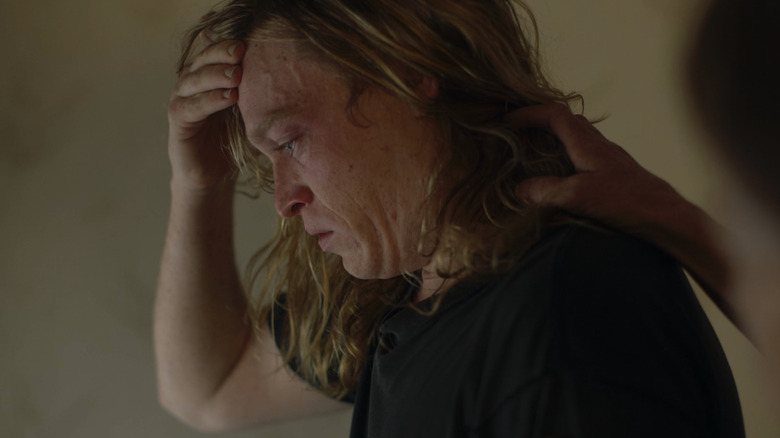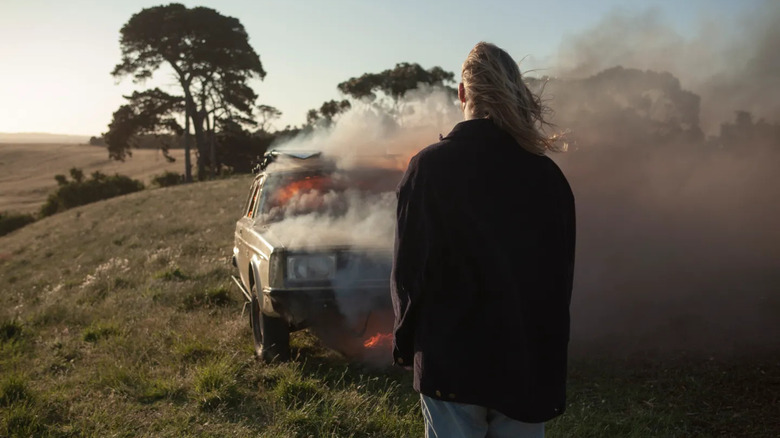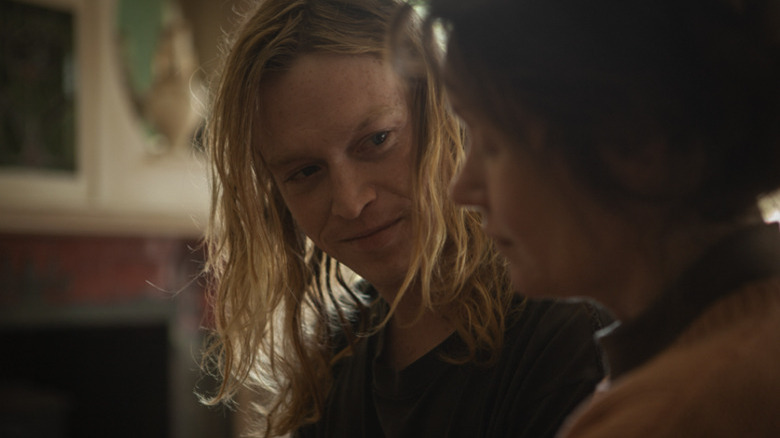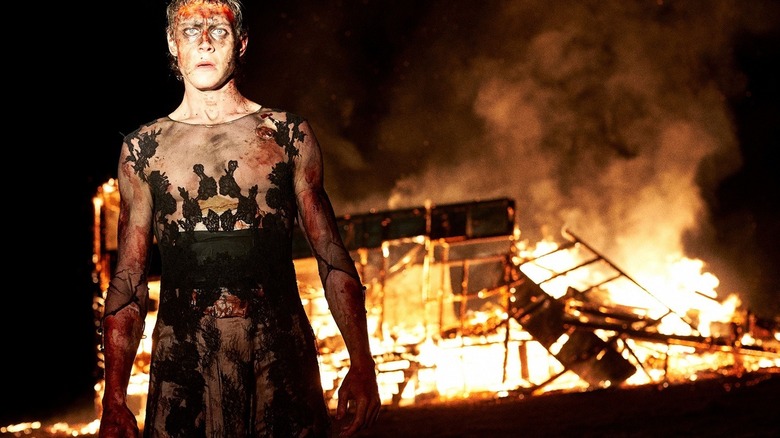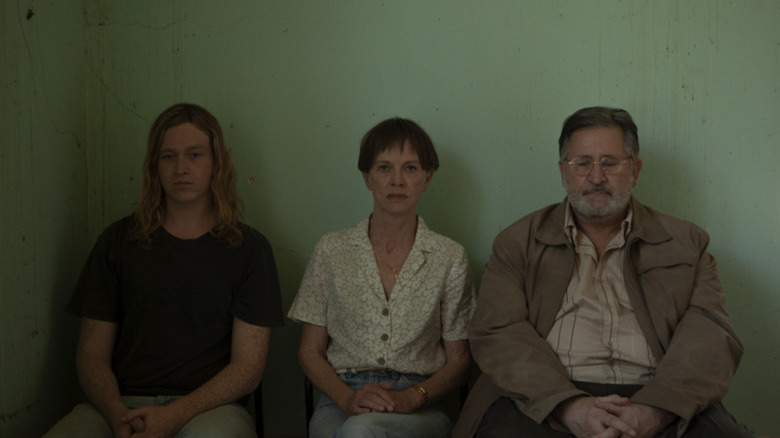Nitram Director Justin Kurzel Explains How Australia Influences Him As A Filmmaker [Interview]
Filmmaker Justin Kurzel has described "Nitram" as the most difficult film of his career. The movie dramatizes the build-up to the 1996 mass shooting in Port Arthur, Australia, which left 35 people dead and 23 wounded. In the aftermath, both sides of the aisle in Australia came together to pass the National Firearms Agreement, which restricted owning semi-automatic weapons among other dangerous weapons.
As is usually the case with Kurzel's work, "Nitram" is an uncompromising, unflinching film that crawls beneath the skin and stays put there. Over the last decade, the director has been telling stories about men of violence, such as his exhilarating retelling of "Macbeth," the myth-shattering "True History of the Kelly Gang," and to a certain extent, even his adaptation of "Assassin's Creed." With only a few films to his name, we already know what interests Kurzel as a storyteller. Recently, the filmmaker told us about his influences, what draws him to certain themes, and the questions he's still asking himself about "Nitram."
'We do struggle to have conversations about our dark chapters'
When you first received the script, you took a deep breath and asked, "How and why?" What answers did you arrive at?
I don't think I came out of the end of the film understanding exactly why and how it happened. I think it was always a reach back into a pretty dark chapter in Australian history and trying to, I guess, track and see how someone who was dangerous was able to do what they were able to do back then. So, I guess the things that weren't so obvious, in regards to a character like this in the film, being able to get access to that weaponry and how the system at the time really failed.
The aspects of his isolation and the family drama around the film that played out, especially the relationship with the mother, was something that I think developed as we were shooting and started to evolve a lot in the edit. We made it in a bubble of a pretty isolating time that we've all gone through, and there was definitely an intimate connection to all of that, of just how easy it is for someone to disconnect to the world and to their circumstances, and start to, I guess, search for answers in other places and ultimately make some weird choices.
I guess that was the biggest surprise, that sort of social drama. There's a familiarity in something very recognizable about that family that started to feel a little less like the monster down the street and a little more like maybe we pass these people, or maybe we pass these families every day.
And just to be clear, when I was quoting you about the how and why, I do not think this film tries to overtly answer any questions.
Sure, sure, sure.
It's observational, but it does seem that you're still asking questions about the importance of telling a story like this, and the how and why in that regard.
Yeah, that's been a constant question that I've asked. I've spoken to survivors and I've spoken to people that desperately didn't want this film to be made and don't think it should exist. And then I've spoken to a lot of young people that weren't even born around that time, living in Tasmania, that wanted to know what this big dark shadow is over their shoulders in this place, and why and how it happened and why they can't talk about it.
In Australia, we do struggle to have conversations about our dark chapters. It is a place that was settled in an odd way, so there is a history of violence in Australia that we all find quite difficult to face. So, it's been really mixed, my experience with the way people have responded to the film. I think those that had massive apprehensions about it, I think have felt relief that it was something that they were hoping it was not.
When Sean wrote it — and I live in Tasmania, which is where the shootings happened — I was petrified of it. As we were making it, there was just something that became so familiar about it. I felt as though Sean had written characters that I had met before, that didn't seem so distant. That's what was so shocking about then suddenly seeing that character walk into that gun store and buy that weaponry and make those choices, is that I could sort of feel the steps there.
I could feel the family's conversations, the fatigue in the mother, the sense of maybe this is someone that we've walked past many times before. I thought a lot about myself growing up and what my relationship with these outliers were.
To your point, there are still a lot of people that don't know about this event. Did you have that question for yourself, too, of just creating that dialogue with people that are unaware, to remind people this event should not be forgotten?
Yeah. We are just not surrounded by guns like you are in America. For us to see a gun, it's a once in a lifetime thing. A lot of that is due to what changed after Port Arthur. I mean, it was seismic, and that's a pretty extraordinary response to a tragedy. It was 25 years ago, so there's a lot of young people that obviously weren't affected, were like one or two or three at the time when it happened, or that were born after the event. But I remember it: I remember viscerally the change in temperature and the shock of it and the anger at something needing to be done.
25 years later, those laws are now starting to be weakened. There's lobbying to have them changed. The shocking memory of the day, I know for some will never pass. It's there, like it's been there forever. But for others, it's distant. So there was definitely a conscious choice in Sean and I to bring to screen, "Hey, it wasn't that long ago that this took place and the events leading up to it." They were familiar.
'I tried to stay as distant as possible as a director'
Have you noticed conversations about the film depend on where you're showing it?
The dialogue in the UK is very similar to Australia in that I think there were very particular shootings that happened in the UK, such as Dunblane, which features in the film, where it was shocking and seismic enough for reforms to happen very, very quickly at a very rapid rate. I think having conversations with Americans about the film, I noticed that there's a sort of hopelessness a little bit in just how seismic the changes would need to be in America. You can just see that from the statistics and the figures of how many shootings there are in a year, like no other country. It's just very different.
Like you said [before we started the interview], guns have been around you all your life, gone through school and had to have the security checks, and that it's been a constant thing in your life. It's just very, very different to the upbringing I've had in Australia, where it was unbelievably rare to hear or see them. So I really appreciate that it's a very, very different conversation wherever you are about this film, especially about gun control.
I always think when I see a film that tackles this subject, "Well, this fear is a part of our everyday lives. Why shouldn't we be showing this beyond the news? Why not show this part of life, of humanity in films, music, or any art form?"
Yeah. Well, it's interesting. The film was influenced heavily by Sean Grant, the writer, while he was living in Los Angeles and had a couple close calls with some mass shootings that had happened here in Los Angeles. I find it quite interesting that Sean being an Australian writer living in Los Angeles and really feeling the effects of guns around him, that was enough for him to look back on that one event in Australia, which changed things forever in Australia. But there's a ... it's so unusual in Australia to be talking about guns or thinking about them. Whereas here, it's all around you.
It's a terrifying feeling. Again, this movie has an observational aesthetic, but you tend to be a very expressionistic filmmaker. What did you want the camera to do or not do with "Nitram"?
Just much simpler, really trying to kind of stay out of the way of it. I guess in my other films, there's been some strong stylistic choices there and cinematic choices. And this one, I tried to stay as distant as possible as a director. We shot it very, very quickly. I did very, very few takes on it. I didn't want to overuse the music in it. And the camera feels distant, as if it's watching someone from afar a little. I was very conscious of Caleb's performance being incredibly nuanced in that you were very, very uncertain throughout the whole film as to what their point of view was.
It was a slow sort of unpeeling of an onion, as opposed to it really driving the film. So, yeah, definitely there's a sort of a distance there as a filmmaker, and a watchfulness. It was the first time I used so many shots of people looking at the lead character. There are a lot of shots of people observing and watching this person. So it was probably the simplest film, and probably the most rewarding film to shoot because of that, and I loved being away from having to impose myself on a film. It was really lovely to be able to kind of just allow the film to speak for itself in the most simplest way it could possibly be.
What was the motivation behind those shots showing how people are reacting to him?
Well, I just thought a lot of it was about how others were feeling about him and that viewing those close to him, sharing their trepidation or their empathy or their need to understand, sort of felt like the right way into this character. You needed to experience this character through the other characters' experiences, as opposed to you being that far up close to it and being led.
Because whenever we did do that, whenever there was a — whether it was music or whether it was Caleb being too dangerous or slightly more pushed — it felt led and somehow felt like it wasn't the right cadence for the film. Whereas when you view the character through the lens of someone else, and especially as you're getting towards the end and that Judy Davis' character, the mother, the trepidation and the fear and how alienating she starts to become with him at the end, I think adds to the danger of him. Your own mother is looking at you like someone that she can't recognize anymore. That is so much more powerful than you feeling that one on one with the character.
Helen, the character, introduces him to music and life and art, and you're smiling at him. You suddenly kind of get to feel a different side to that character through someone else's tolerance and patience and love, in a way. So it was really interesting how those other characters became very important in having a relationship with someone who, at the end of the film, does something horrific. They became beacons and vessels to be able to explore that sort of person.
'We kind of want to understand who we are and the violence that we come from'
Earlier you said how guns, at least in Australia, weren't present much for your upbringing. Your movies do tend to follow violent men, though. What draws you to these characters?
Well, Sean, the writer, we've now done three films together that are about violence and especially violence in men. I don't know what that is. I think we both come from places and communities and upbringings that were challenging and that had very strong male figures around us. So there's an aspect of that that's always intrigued us. In Australia, that sort of alpha male is a very strong presence, that if you're not part of that alpha tribe in terms of sport, or if you're not a surfer, or if you're not kind of in that particular tribe, you do feel like an outlier pretty quickly.
It's a tribe that can be unbelievably exciting and life affirming. It's also a tribe that can be dangerous and also violent. So, I don't know what it is. Our country was sort of settled on violence in that of all the worst genocides that happened, happened in Australia with our indigenous people. It has a history of violence and brutality towards each other, and towards those that were living there before white settlement. It's definitely part of the Australian legacy.
We find it very, very difficult to sort of face it, and to be truthful about it. Yet, a lot of our films are about it. There are a lot of quite violent characters in our films that seem to exist. There's got to be some sort of legacy there that we're trying to question, I think.
You definitely confronted that in the "True History of the Kelly Gang."
Well, we had this weird thing with the Kelly Gang, he's become this icon in Australia. We seem to do that with a lot of criminal identities in Australia. They become part of our culture like Ned Kelly did. There's obviously a sort of fascination there with those. Ned Kelly was very different in that it was an event and a figure that has been definitely buried and viewed in an almost impossible way to have a conversation about. So, yeah, it's interesting. We kind of want to understand who we are and the violence that we come from, but at the same time, we find it pretty difficult to face it.
'You constantly just feel like you're being watched'
Aesthetically, what about Australia has influenced you as a visual storyteller?
Australia's just a really visual place. I think the landscape's so seductive. You can feel mythology around you and we listen to a lot of music and you always associate — we're in a car constantly, and we are traveling across landscapes constantly and we listen to music constantly as we drive. The whole place is so cinematic. It does start to make you think about things in a particular point of view, visually.
I mean, even in "Nitram," even though it sort of happened in suburban Australia, the sounds of birds and lawn mowers, the cars and wheelies at the end of the street and speeding off, all those sort of sounds are so vivid in Australia, they seem to be really ripe for your imagination.
I was never bored as a kid growing up. I always felt as though there was something monumental just happening down the road or I drove past every day. I think it's why we produce so many really great directors and especially cinematographers. I think it's because it is really cinematic living there, and I think just the place has been a huge influence on me.
Hearing about your upbringing and influences, it makes sense why "Macbeth," after countless retellings, felt so fresh and exciting coming from that point of view.
Yeah, yeah. Well, Scotland reminded me a lot of Australia and everywhere you looked, you just went, "Well, of course, Macbeth is from here." Scotland just feels like a Western. I mean, the biggest influence of that film was that "Macbeth" is a Western. It's crazy. This landscape, why wouldn't there be witches about this landscape? Why wouldn't it take five days to travel by horse from there to there? It felt like an Australian landscape or an American landscape. There was just something about it that was incredibly cinematic, when you hear the verse and you go, "Well, you can kind of see it. You don't need to describe it in the verse. It's happening in front of us."
The idea that witches would be in that sort of landscape is no different from feeling as though there are bunyips living in rivers in Australia. Like, I constantly feel as if I'm on a turnaround and see something that I shouldn't see, something that's been dead for ages or something that doesn't exist. It really is that sort of place. You constantly just feel like you're being watched. It can be quite overwhelming at times.
"Nitram" is now playing in limited release, VOD, digital rental, and on AMC+.
